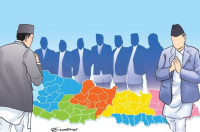Columns
The news-knowledge divide
Press freedom should be about more than just defending the media from political interference.
Dharma Adhikari
You may find few stories about journalism that generate so many spontaneous headlines in our media. The annual observance of the International Press Freedom Day is, unmistakably, one such example. For a press system historically subjected to periodic bouts of political interference, the symbolic significance of the day cannot be underestimated. However, the occasion and the coverage of the ceremonies, as on May 3, remain little more than a ritual for the media fraternity and the public in general.
For today’s journalism—which faces existential threats from alternative platforms, shrinking revenues and declining public trust—press freedom should be more than just defending the media from political interference or attacks on their independence. It should link press freedom to society and the wider culture, to the lives of the audience and the general public, who have emerged as key players in deciding, framing and making news independently. Fortifying journalism or its underlying values or ideas risks alienating audiences, the new partners in crime (as well as virtue).
The growing trust deficit in the news media owes a lot to a stark lack of dialogue between journalists and their audiences about journalism and its processes, as reflected in the news knowledge divide. Social media appears to facilitate more spats and insults between journalists and audiences than meaningful, issue-focused exchanges. They don’t seem eager for a shared understanding of what news is or can be and how the news production process works.
For a journalist whose work involves factual news (and, occasionally, interpretation and commentary on current affairs), not all information is news unless it has some news value and a distinct structure organised in order of importance. However, a user driven by personal relevance may not see the need to distinguish between a status post and news. The word “press,” derived from the now vanishing printing press, probably sounds rusty or even funny to an average reader used to clicks. What or whom do journalists press? Few would associate it with print, hard news or the core of journalism.
Accusation of partisan bias is one of Nepali media’s major blemishes and a contributor to public distrust. Audiences often read one article or a headline and reach their conclusion, though journalists would insist that bias is about treating someone unfairly across many stories from an outlet, over time, and knowingly. Proving a consistent pattern of unfairness over time takes much more than a cursory reading of a single story, but few would spare the time or patience to do so.
Contexts of news production give rise to ethical questions, such as in the recent case of leaked audio of a conversation between a TV anchor and her story subject. The anchor clarified in the clip that a story she did involving the interviewee was put on hold simply for the lack of a sponsor to help cover the cost of programme airtime, a normal practice in the industry. The leak earned her and her station widespread criticism and accusations of potentially killing the story for money. It does cost to get a story out, and there is nothing wrong in seeking legitimate sources of revenues, as long as the news process is kept transparent enough. Only genuine dialogue between journalists and users or commenters will help diminish the gulf of understanding between the two sides.
Without a meaningful exchange, such misgivings are sure to persist. And semantics is often at the advantage of anyone who knows how to use it. In everyday life, how words are perceived is often more significant to users than how they are defined. Just as “fake news,” as opposed to disinformation, is weaponised primarily by officials and other sources to attack the news media, “press freedom” has now been vulgarised to the point of impudence. For the detractors of independent media, the phrase is synonymous with “freedom from the press.” How the general public perceives such labels contributes much to the news media’s image problem today and, thus, to their declining trust and credibility.
Here is a popular and rather defensive phrase often making rounds in cyberspace in recent years: Journalism is not a crime. The slogan does state a principled position on what journalism is not but ends up tacitly acknowledging that journalistic activities are being increasingly viewed as criminal. It ends up inadvertently amplifying such views. Dialogue is hindered online by such endless semantic twists.
Still, studies have shown that transparency in the editorial process—laying bare the context of news gathering and production—is key to bridging the news knowledge divide and regaining media trust. This is in line with findings that confirm that news literacy, or news fluency, helps users identify quality information and engage critically online.
Identifying and fostering elements of news knowledge for our context will take a collective effort. News professionals are busy promoting their bylines, individual stories, or brands, and there is hardly any collective stewardship for journalism overall. The professional fraternity, as well as the netizens online, are too fractured and self-seeking to be able to work for the common good of the entire community.
On a sustainable basis, news organisations themselves may lead in engaging the public through in-house efforts and in collaboration with fact-checking initiatives and academic programmes. For instance, the BBC College of Journalism or the School of the New York Times anchor on the business strategies of their parent media organisations. Our media should initiate scholastic journalism initiatives not only to foster news fluency among the young but also to inculcate a discerning generation of their own audiences.




 14.12°C Kathmandu
14.12°C Kathmandu















